7 n8n Alternatives for Every Use Case (No-Code to Dev-First)
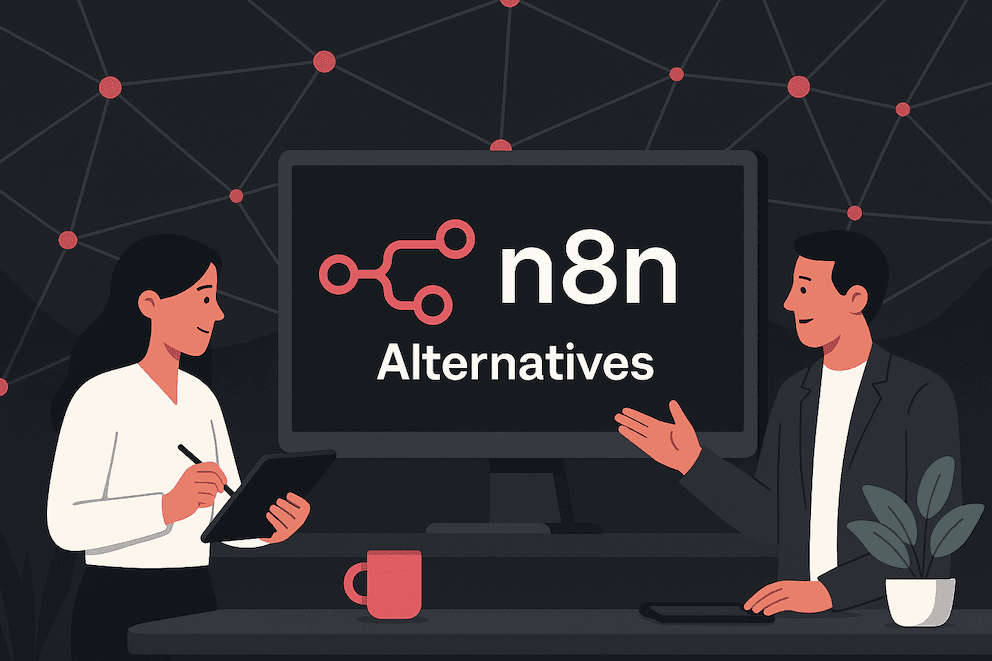
At first, n8n looks like the answer: open source, self-hosted, and packed with options. Once the workflows get more serious, the cracks start to show.
Setting things up takes longer than expected, AI agents don't run smoothly, and the visual builder feels messy when flows get big. That's when people start asking what else is out there.
This guide breaks down seven n8n alternatives and shows why Activepieces has become the clear favorite.
Sign up for free to see why businesses prefer Activepieces over n8n!
Why n8n Isn't Always the Right AI-Powered Automation Platform?
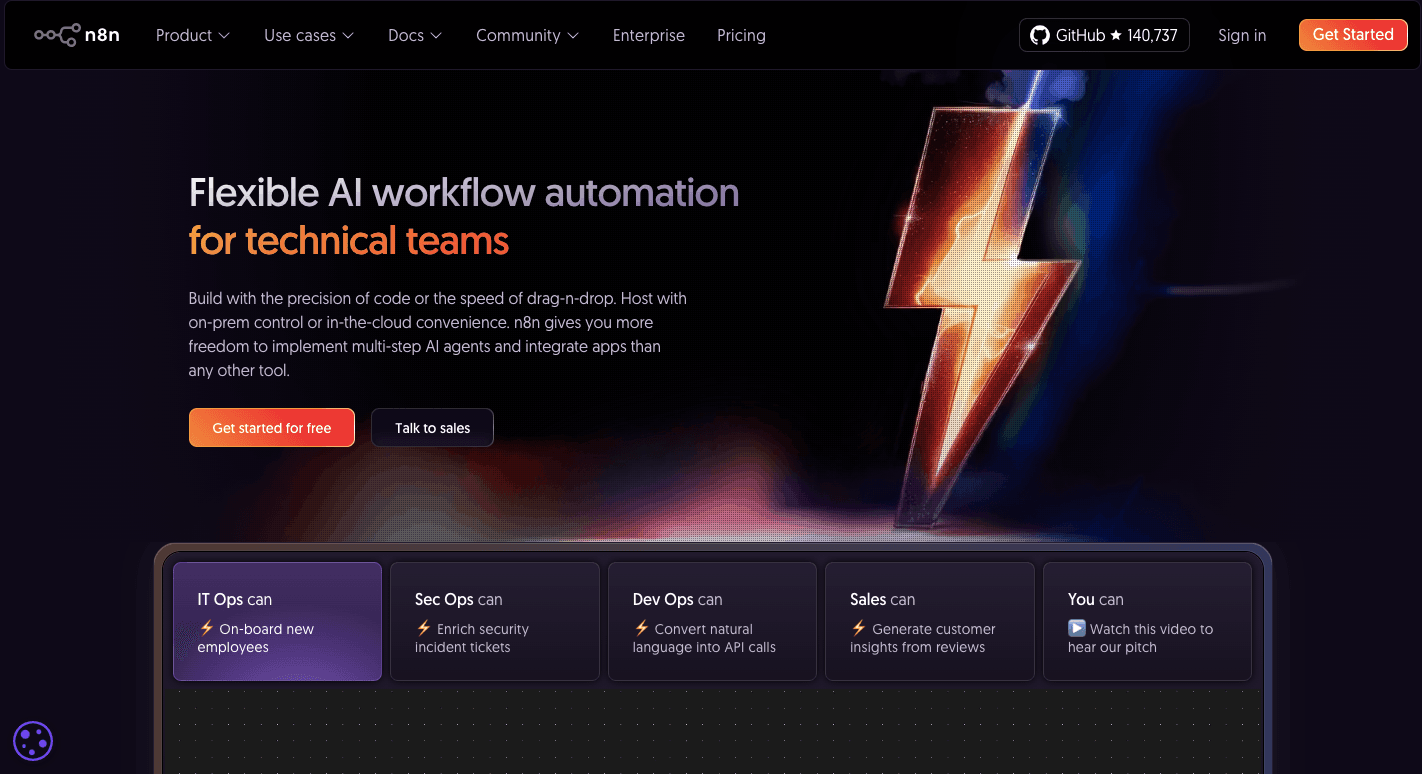
n8n, a low-code automation platform, lets you connect apps through a node-based canvas. Each node is a task, and when you link them, you get a workflow that runs from a trigger.
You can add branches with conditional logic, insert data transformations, and build with lots of custom logic. Developers like that it feels closer to a flow-based programming tool than a simple connector.
Yet many experience these downsides:
- You need a technical setup if you self host.
- Has a steeper learning curve than other AI automation platforms.
- The cloud version has usage limits tied to plan tiers.
- The visual builder gets messy once flows grow, which makes it tough for non-technical users to follow.
- Agents don't hold memory between runs unless you bolt on an external database.
- Error handling has to be written by hand.
These add friction, especially when workflows grow large or you try to build mission-critical workflows.
n8n can do a lot, but it often fits better as a developer-centric automation platform. Many teams eventually look for faster options that come with AI features and handle complex logic.
7 Best Workflow Automation Tools Beyond n8n
When n8n feels too complicated, you look for alternatives. Some of these workflow automation platforms include advanced AI capabilities or support for multi-step workflows. Many also provide a more intuitive interface that makes building easier for any team.
1. Activepieces
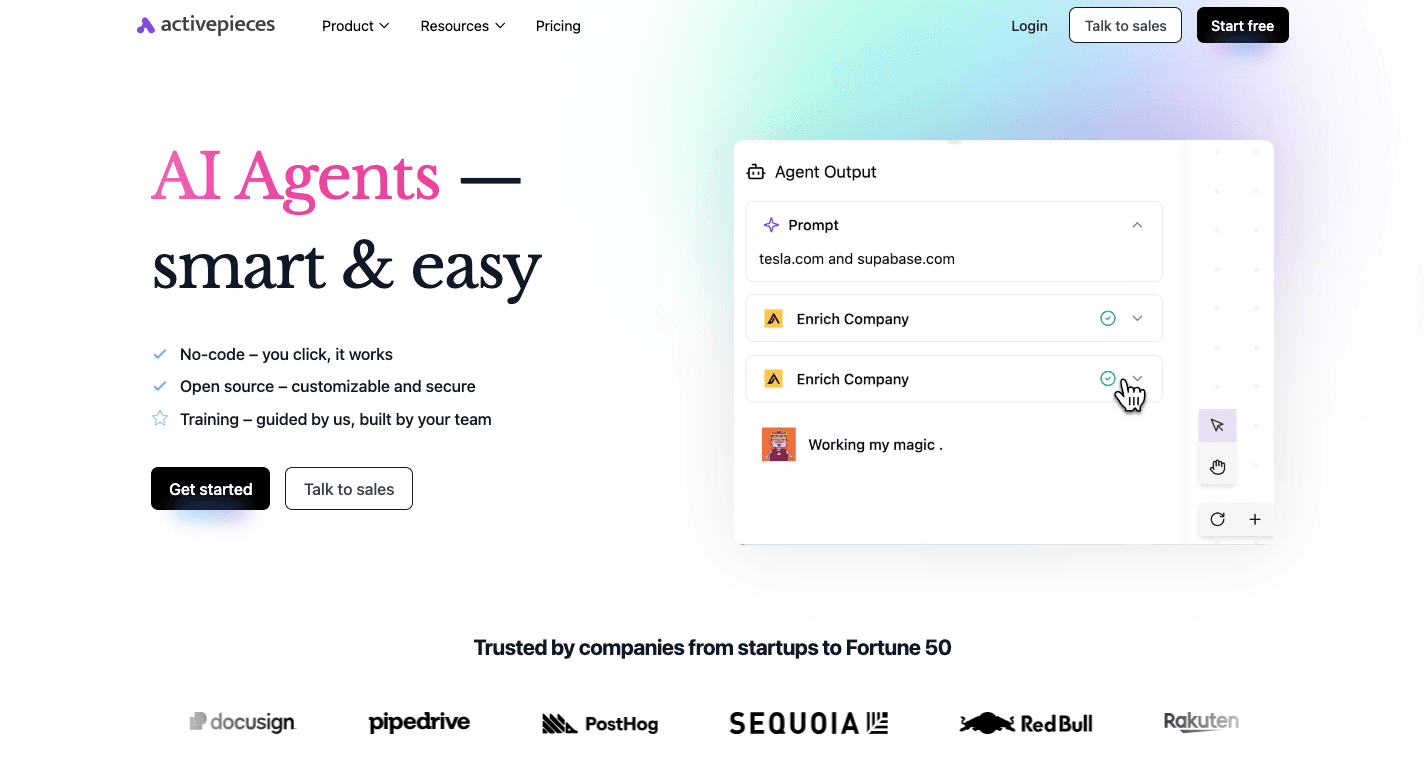
Activepieces is an open-source automation tool for small teams and large enterprises. Non-technical users appreciate the drag-and-drop interface, while developers can extend the platform with TypeScript-based "pieces."
The design uses a step-based flow, which stays readable even when automations get long. That's a sharp contrast to n8n's node-heavy setup.
There's even a huge app library of 425 pre-built integrations, so you can quickly set up ecommerce workflows, link sales apps with CRMs, or manage approvals in HR. You don't need to reinvent the wheel every time. Instead, you start with proven templates and customize further.
Those who want convenience can run on cloud hosting, while organizations with stricter requirements can go self-hosted. Features like inline debugging, native AI agents, and a built-in database show that Activepieces gives you advanced options to match your needs.
Features
Activepieces includes features for quick automations and large-scale projects.
- Visual builder with advanced logic - A step-based flow that makes it simple to design yet powerful enough to handle complex rules.
- Pre-built integrations - Hundreds of ready-made connectors across AI, marketing, productivity, and CRM systems.
- Custom workflows - Extend automations with TypeScript-based community contributions or build your own.
- AI-ready steps - Integrate OpenAI, Claude, and ElevenLabs natively, or add AI agents into workflows.
- Built-in database - Tables provide a lightweight way to store workflow data without external tools.
- Inline debugging - Check each step's input and output to simplify error handling.
- Human-in-the-loop - Pause flows for approvals or add manual checks where needed.
- Secure deployment - Options for cloud hosting or self-hosted environments, depending on control needs.
Integrations
Activepieces supports 425 pre-built integrations as of now, though that number changes often because the library keeps growing.
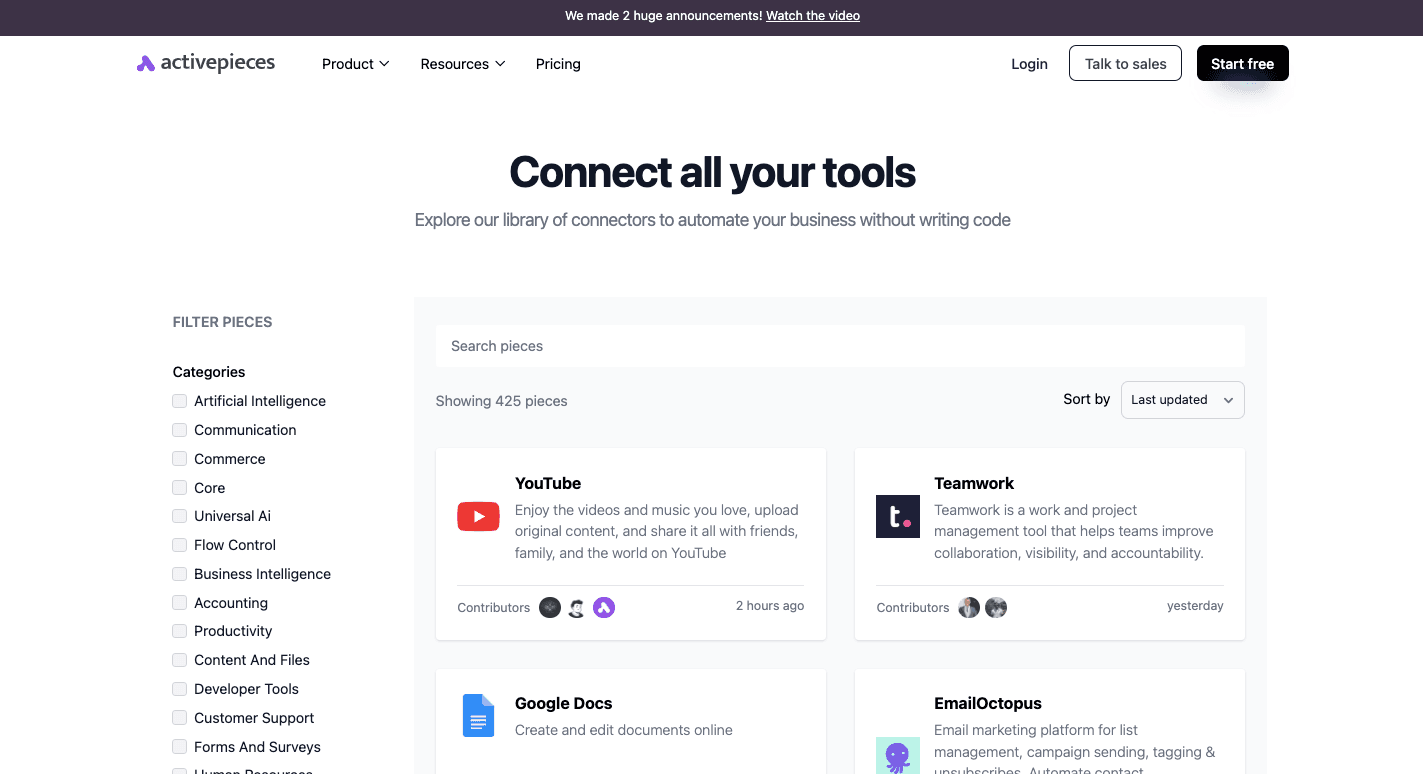
The huge app library includes everything from core productivity apps to advanced AI services:
- Google Sheets
- Microsoft Excel 365
- Slack
- OpenAI
- Google Gemini
- ElevenLabs
- WordPress
- ActiveCampaign
- Microsoft Dynamics
- Zoho Desk
- Shopify
Since many integrations come from the community, the catalog expands steadily. You can expect new pieces to appear regularly without waiting on vendor timelines.
Use Cases
Activepieces adapts to different departments and workloads. Non-technical users can build simple flows in minutes, while technical teams create custom workflows with more detail.
Some of Activepieces' AI use cases:
- Sync Shopify data into Google Sheets for eCommerce workflows.
- Automate repetitive HR tasks like onboarding approvals.
- Send Slack notifications from CRM updates.
- Use AI agents to handle SEO drafts, emails, or content reviews.
- Create IT automations for password resets or service requests.
Pricing
Activepieces offers a free self-hosted Community Edition, plus cloud tiers with transparent rates.
The free cloud plan includes a thousand tasks each month, while the Plus plan at $25 per month offers unlimited tasks under fair use. On the other hand, the Business plan at $150 per month adds more projects, flows, and AI credits.
You can also select the Enterprise plan that uses custom pricing to match larger deployments.
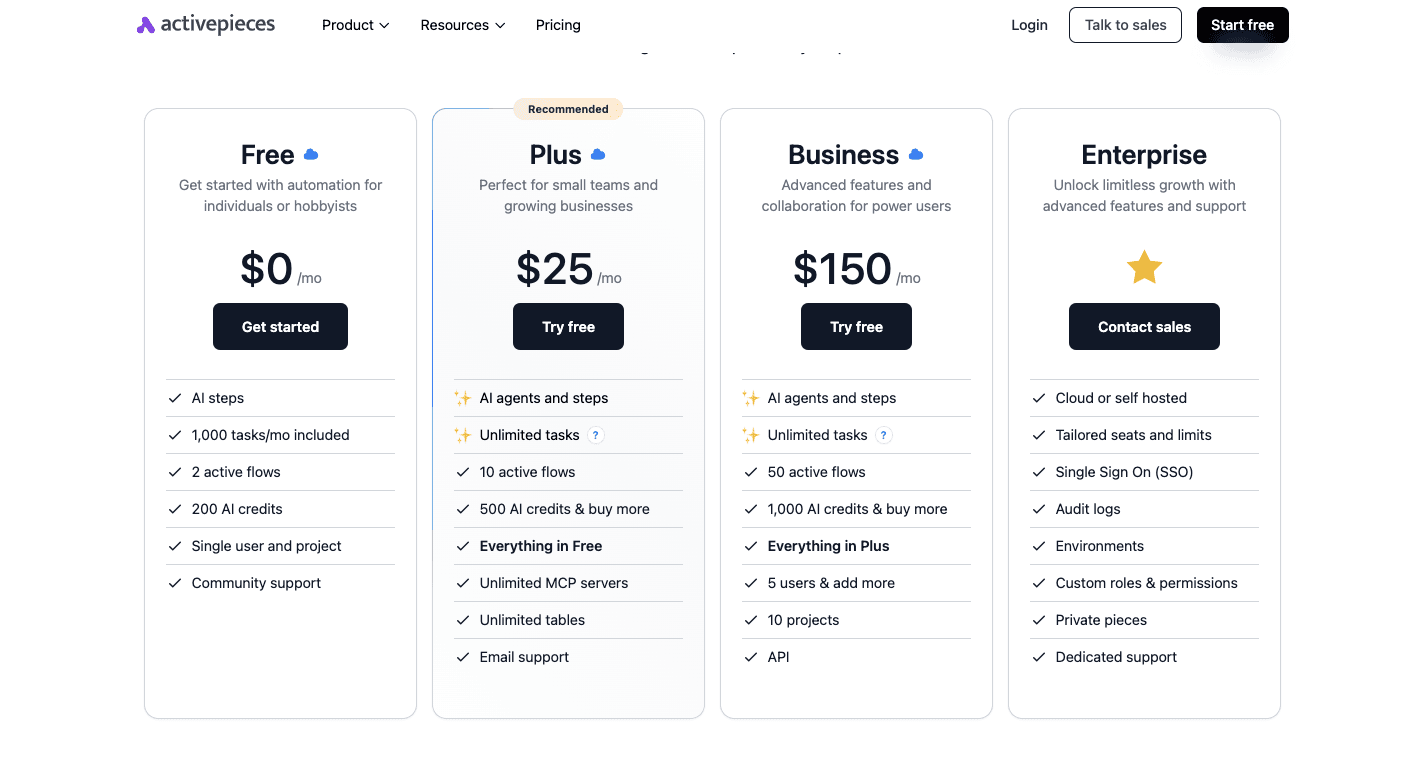
Compared to n8n, Activepieces' pricing is much simpler. N8n Cloud uses strict usage limits tied to subscription tiers, which can restrict high-volume teams. Self-hosting n8n is free but requires you to manage the infrastructure yourself.
Activepieces balances both: you can run self-hosted on your own server for control, or pay a flat rate for cloud hosting with unlimited tasks.
Speak with our experts and find the right setup for your business!
2. Apache Airflow
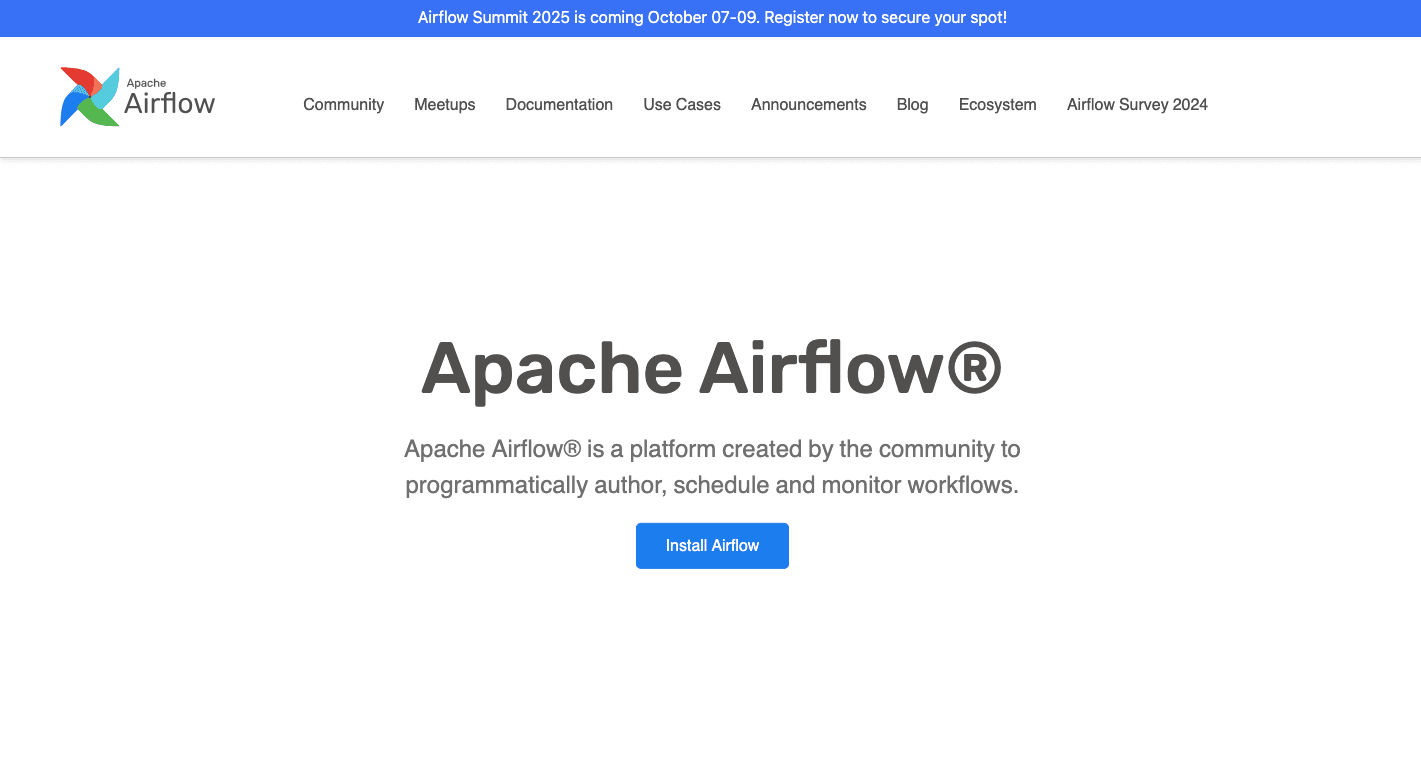
Apache Airflow started at Airbnb in 2014 and quickly spread through data-heavy industries. For data engineers who need to automate ETL or ELT pipelines, it offers the control they expect. Many describe it as a developer-centric automation platform, since everything is defined in Python code.
The system is well-suited for orchestrating complex data workflows. Tasks are written as code, then arranged into Directed Acyclic Graphs (DAGs) that show dependencies.
Once defined, Airflow schedules and executes each task in the right order. The metadata database records every step, storing audit logs and results, while the web interface lets you watch progress in real time.
You have direct and extensive code-level control, too. But that raises the bar for setup and maintenance. That won't be an issue if your teams have a technical background. However, this won't be the case for non-technical users.
In short, Airflow is better for pipelines that move large volumes of data and require advanced scheduling. For lighter business use cases, though, it often feels like too much work compared to simpler tools.
Features
Airflow's features include:
- Workflows as code - Write pipelines in Python using functions, loops, and conditions.
- Directed acyclic graphs (DAGs) - Map out task order without circular dependencies.
- Web UI - Visualize DAGs, inspect task logs, and check workflow health.
- Extensibility - Create custom operators or hooks to work with almost any API or system.
- Scheduling - Support for cron-like schedules and event-based triggers.
- Scalability - Use Celery or Kubernetes executors to run tasks across clusters.
- Integrations - Hundreds of pre-built providers for cloud platforms and databases.
Pros
- Highly extensible with custom components.
- Pipelines as code allow versioning and testing.
- Distributed architecture scales horizontally.
- Backed by an active open-source community.
Cons
- Steeper learning curve compared to simpler tools.
- Requires ongoing infrastructure management.
- Optimized for batch workflows, not real-time streaming.
- Not suitable for non-technical users.
Pricing
Airflow has no license costs since it's open source. The true cost shows up in how you deploy it. Running it on your own requires servers, databases, and staff who can manage infrastructure.
Some organizations choose cloud hosting, which adds costs for compute and storage resources. Others use managed services like Astronomer or Google Cloud Composer to avoid the overhead of self-hosting.
3. Kissflow
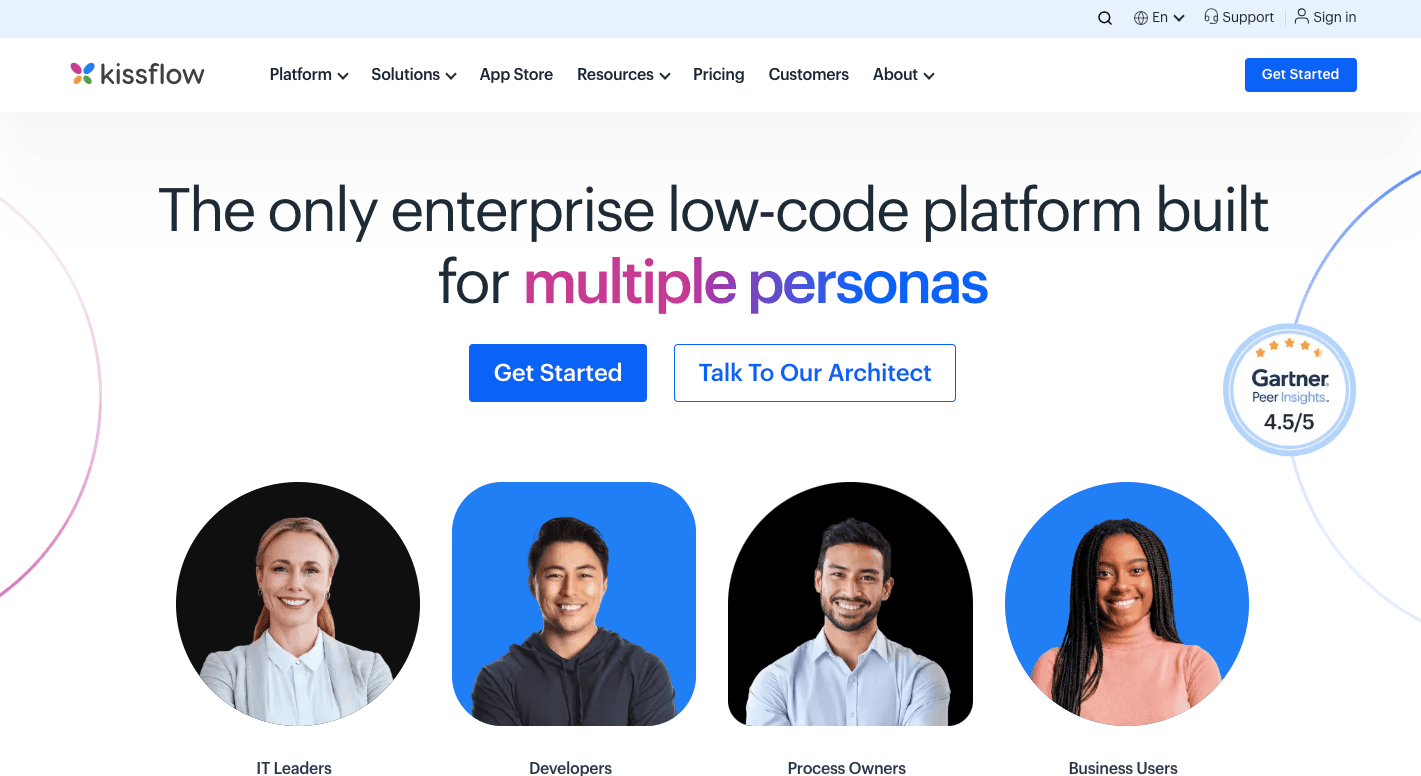
Small and mid-sized companies that want quick results without heavy technical support usually use Kissflow. It includes a visual workflow builder to lay out processes step by step. Non-technical teams can create workflows for HR, finance, or IT approvals without relying on developers.
At the same time, it's not only for beginners. Kissflow supports more complex automation by adding low-code options for IT staff who need to handle integrations or rules that go beyond simple workflows. It enables users to create applications, manage cases, and even combine structured and unstructured work in one place.
Kissflow further connects to a variety of business apps for data syncing, such as Google Workspace, Microsoft 365, and CRMs. And to keep an eye on performance, you get built-in templates and dashboards.
Features
Kissflow offers features to simplify automation while giving room for customization.
- Visual workflow builder - Design processes step by step without touching code.
- App builder - Build business apps with no-code or low-code tools.
- Form builder - Create custom forms with drag-and-drop fields and rules.
- Pre-built templates - Speed up deployment with more than 160 ready-to-use options.
- Decision tables - Apply rules to guide approvals and complex decisions.
- AI features - Add intelligence for routing, task assignments, or predictions.
- Kanban boards - Manage projects or cases visually with drag-and-drop boards.
- Integrations - Connect to external systems with APIs, connectors, and webhooks.
- Data syncing - Keep information aligned across multiple business systems.
- Analytics and reporting - Track workflow performance with dashboards and reports.
Pros
- Rapid deployment with templates.
- Unified tool for workflows, projects, and cases.
- Responsive customer support.
- Reduce paper-based and manual processes.
Cons
- Reporting features may feel basic.
- Customization is limited compared to code-heavy tools.
- Occasional performance slowdowns.
- Integrations may feel shallow for enterprise systems.
Pricing
Kissflow offers two plans: the Basic and Enterprise.
The Basic plan starts at around $2,500 per month and includes unlimited workflows but has limits on apps, integrations, and analytics. Mid-sized companies that need standard automation often pick it.
Larger organizations often look at the Enterprise plan, which is priced on a custom basis. Enterprise includes everything in the Basic plan plus AI Copilot, unlimited integrations, advanced analytics, and governance controls.
4. Microsoft Power Automate
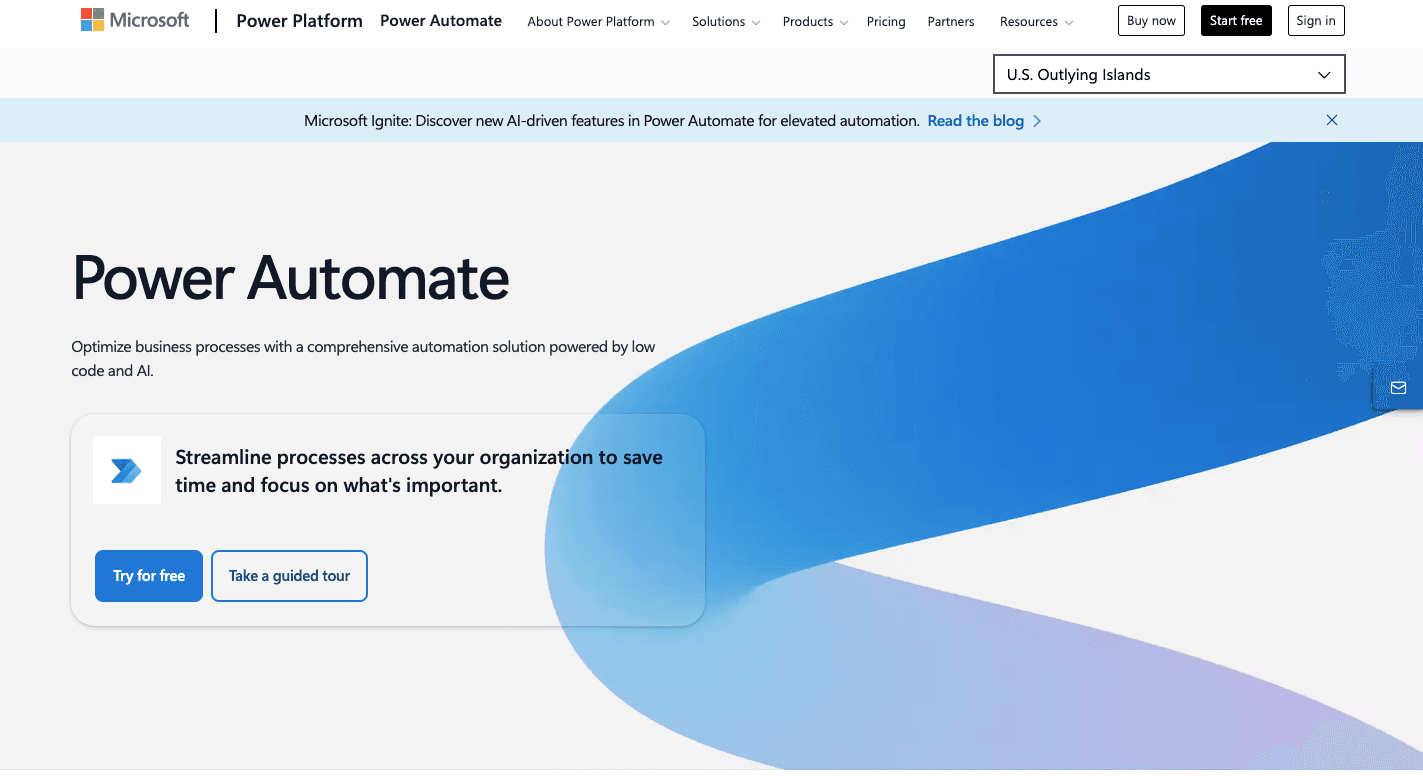
Large companies that already rely on Microsoft apps often use Microsoft Power Automate. People like it since it connects directly to Outlook, Teams, SharePoint, and Dynamics. That connection makes it feel less like a separate tool and more like an extension of the software employees already use every day.
It moves data across apps, triggers alerts, and manages approvals without much manual effort. At the same time, it oversees complex workflows that stretch across departments.
Power Automate focuses more on enterprise automation, so you'll find advanced features like process mining and deep compliance tools. Those matters in bigger environments where oversight is non-negotiable.
You can automate repetitive tasks in finance, HR, sales, or IT, too. The platform even automates workflows that touch cloud systems and desktop apps, so even older software can be included. By bringing in AI Builder, you get text generation, predictions, and document handling as part of your flows.
Features
Power Automate comes with features that match enterprise needs.
- Cloud flows - Automations that run on a schedule, instantly, or based on triggers like emails or form submissions.
- Desktop flows - Automations that record clicks and keystrokes to work with older apps that lack APIs.
- Business process flows - Step-by-step guides for processes such as onboarding or invoice approvals.
- Process mining - Maps workflows across systems and highlights inefficiencies.
- AI Builder - Advanced AI capabilities like form processing, text generation, and predictive insights.
- Connectors - Over a thousand pre-built links to Microsoft and third-party apps.
- Templates - Pre-built flows for common scenarios that shorten setup time.
- Governance - Enterprise controls, audit logs, and DLP policies for compliance.
Pros
- Functions well inside the Microsoft ecosystem.
- Connects with over a thousand apps.
- Can get desktop flows and cloud flows together.
- Adds AI features through AI Builder.
Cons
- Pricing and licensing feel complex.
- Overwhelming for smaller teams.
- Not always simple for non-technical users.
- Struggles with very complex workflows.
Pricing
Power Automate is included at a basic level in many Microsoft 365 licenses, but those versions carry usage limits. Paid plans start at $15 per user each month for the Premium plan. Then, the Process plan runs $150 per bot each month and supports unattended automation across teams.
For companies that want Microsoft to manage the infrastructure, the Hosted Process plan costs $215 per bot each month and includes a hosted virtual machine. The Enterprise plan can become expensive once you add advanced features and governance tools.
5. Tray.ai
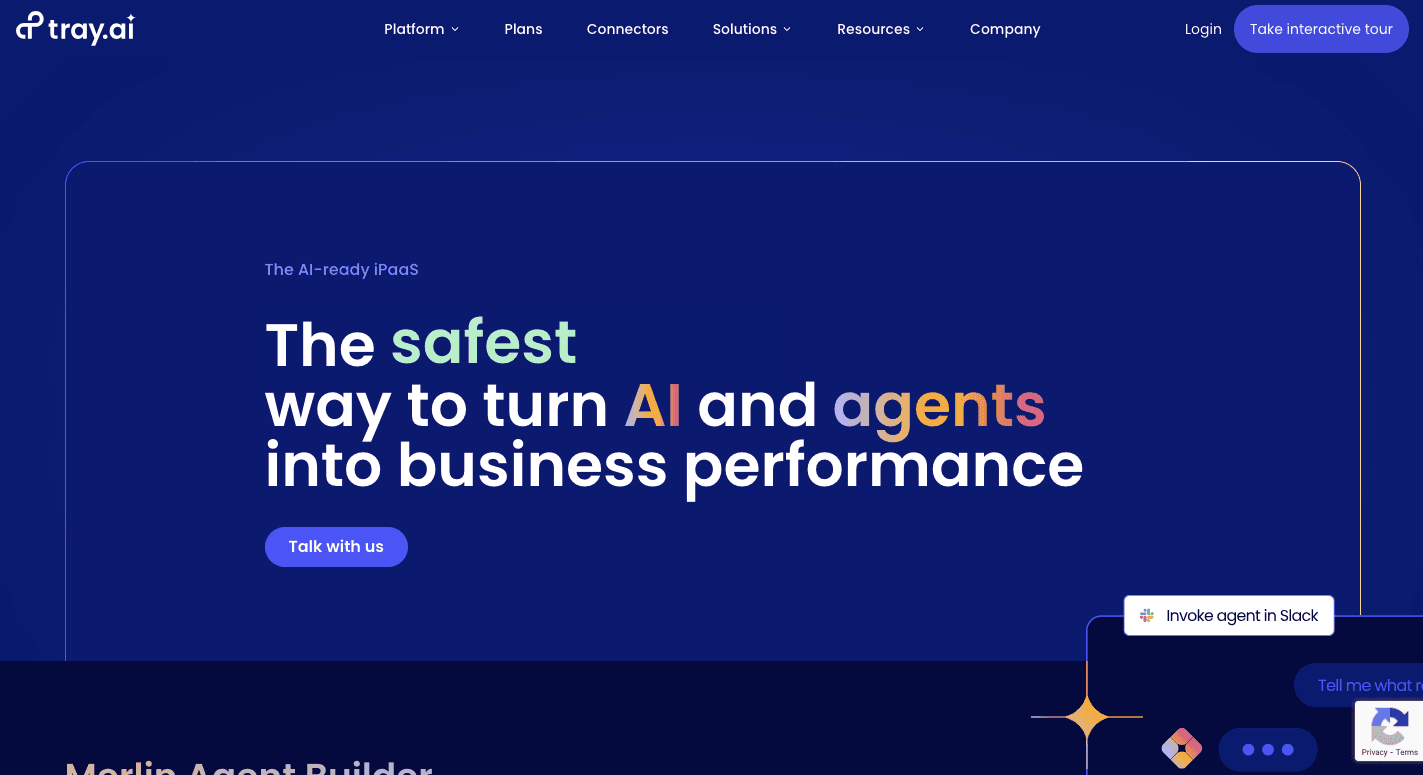
Tray.ai serves companies that need more than simple automations. It operates as a developer-friendly integration platform that handles both routine and large-scale workflows. Many enterprises and technical teams rely on it to connect APIs, sync data across apps, and create flows that require advanced control.
The service comes in two forms: Tray Platform for workflow building and Tray Embedded, which lets SaaS vendors add integrations inside their own products.
Flows begin with a trigger, pull data through connectors, and apply logic or transformations as needed. The system already supports hundreds of apps, including Salesforce, Zendesk, and Google Workspace. It also allows custom integrations when existing connectors aren't enough.
Since rebranding to Tray.ai, it now includes AI-powered agents and tools for processing text, all of which can fit directly into your workflow. Enterprise safeguards round out the offering with compliance, monitoring, and robust governance controls.
Features
Tray.ai mixes visual design with enterprise-grade functions.
- Visual workflow builder - Build flows using drag-and-drop controls.
- Connectors - Access hundreds of apps, with API support for edge cases.
- Conditional logic - Features conditional logic connectors, including the Boolean connector for a simple true or false question.
- Data mapping and transformation - Reformat, map, and clean data as it moves.
- Loops - Run steps across multiple records or repeat actions.
- AI tools - Use Merlin Agent Builder and AI-assisted development.
- Monitoring and error handling - View logs, track runs, and retry failures.
- Insights Hub - Dashboard with usage and performance details.
- Tray Embedded - Lets SaaS companies embed integrations in their apps.
- Enterprise controls - Includes encryption, permissions, and compliance.
Pros
- Wide app and connector coverage.
- Handles complex logic and transformations.
- Embedded option expands integrations for SaaS providers.
- Professional services and support are available.
Cons
- Requires more time to learn than basic platforms.
- Workarounds may be needed for tough cases.
- Support quality varies by account tier.
- Less approachable for non-technical users.
Pricing
Tray.ai bases pricing by usage. Cost depends on the number of flows, users, and API calls, as well as extras like AI features or the Embedded product.
6. Pipedream
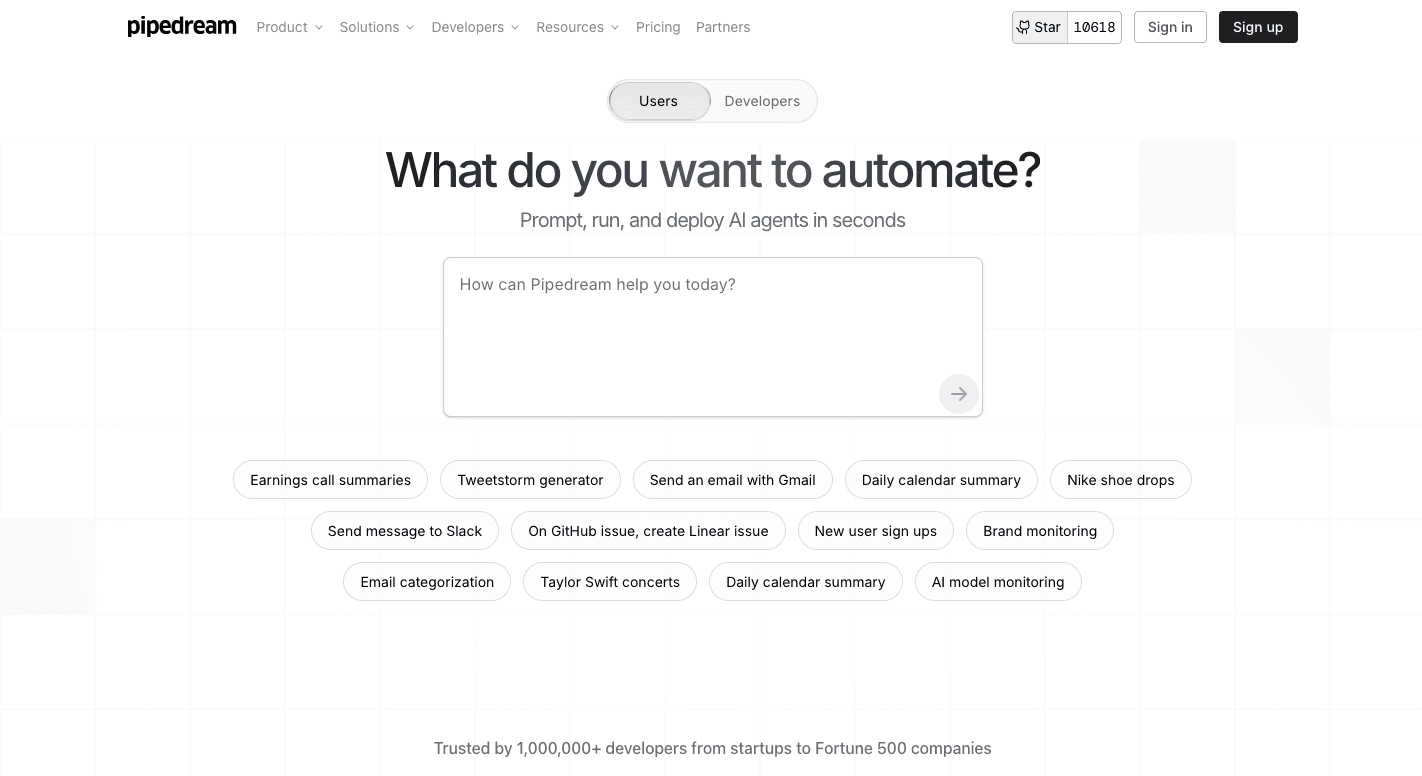
Pipedream acts as an integration platform that controls every step of a workflow. The system runs in a serverless environment, so you can run code without managing infrastructure yourself.
A workflow starts with an event trigger, like a webhook or a scheduled task. From there, you can stack steps, write custom code, or connect to thousands of apps.
Developers get code-level control in Python, Node.js, Go, or Bash. That means you can write scripts that make API calls, transform data, or pull in packages from npm or PyPI.
The platform also syncs with GitHub, so you can version your workflows and collaborate on code. Security is included in the process, with managed tokens and OAuth for app connections.
Features
Pipedream offers you these features:
- Custom code steps - Write in Node.js, Python, Go, or Bash with API calls included.
- Serverless execution - Automations run without the need to manage infrastructure.
- Workflow as an API - Any workflow can be exposed as an endpoint.
- State management - Keep and retrieve data between workflow runs.
- GitHub sync - Version and collaborate directly from GitHub.
- One-click authentication - Securely connect to thousands of apps.
- Real-time observability - Logs show inputs, outputs, and errors.
- Control flow - Build branching paths and conditions into flows.
- Error handling - Retry or catch failures automatically.
Pros
- Mix of no-code and code-based actions.
- Handles deep API integrations with ease.
- Detailed logs help debug workflows.
- GitHub sync supports collaboration.
Cons
- Non-developers may find the learning curve steep.
- Interface feels less polished than other tools.
- The integration list is smaller than some other tools'.
- Not built for large batch processing like Airflow.
Pricing
Pipedream uses credits as its billing base. Each workflow run consumes credits, and the total depends on the plan you're on.
You get a generous free tier that provides a hundred credits a month, along with AI tokens. Premium pricing ranges from $45 for the Basic plan up to $150 for the Connect plan, which includes external authentication features.
Larger teams that need custom pricing or advanced support can move to the Business plan.
7. Pabbly Connect
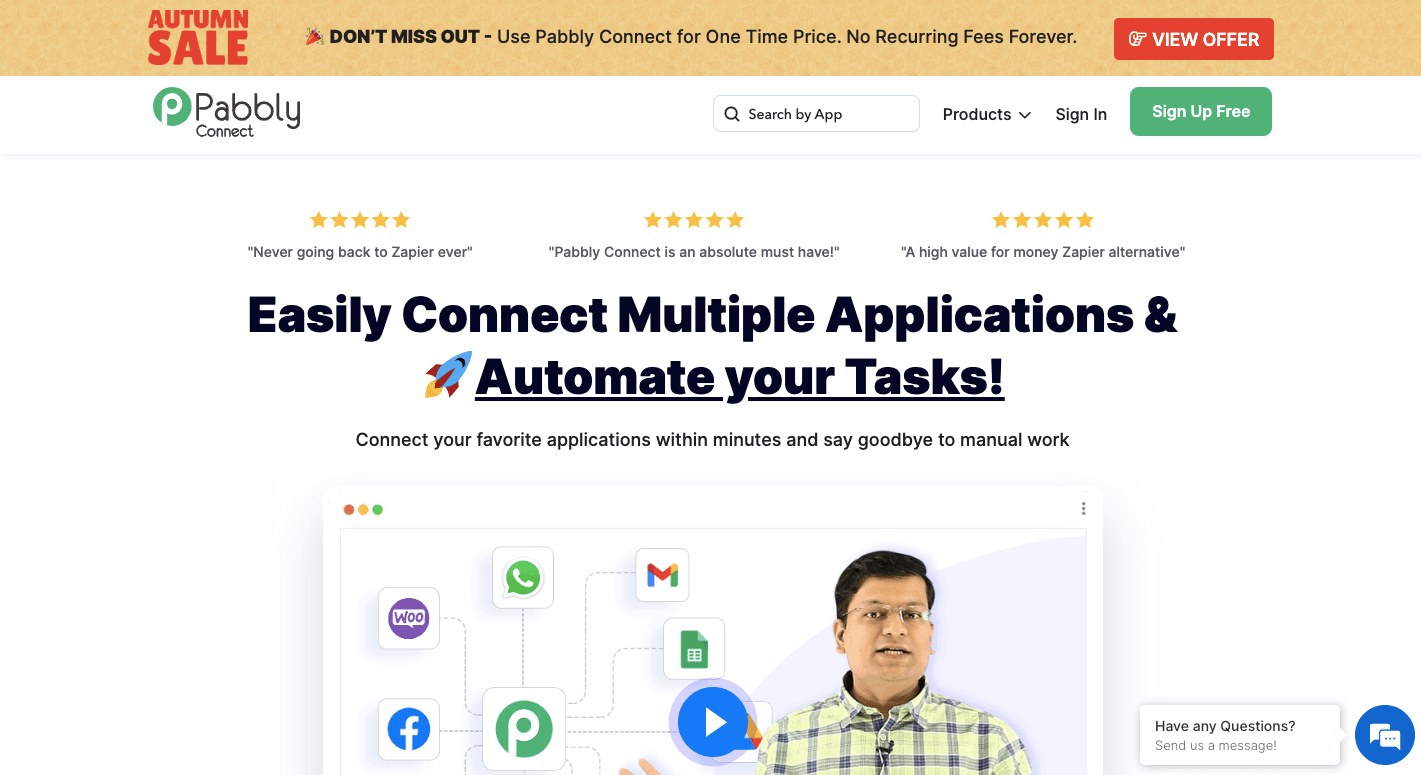
Pabbly Connect is for people who want to link apps without learning to code. It runs on the simple idea of "triggers" and "actions."
You set up an event, like a new Facebook lead, and then choose what happens next, such as saving the lead in Google Sheets or sending a confirmation email. That pattern lets you put together custom workflows without ever touching a line of code.
Besides that, it supports over 2,000 apps, has webhook support for everything else, and includes advanced tools for data transformations. It also includes a visual builder with advanced logic, so you can design flows that handle multiple conditions, approvals, or branches.
Even though it's a more budget-friendly way to manage workflows, you get all the important automation functions. You're not limited to basic "if this, then that" automations, too, since Pabbly Connect is closer to a full integration platform.
Features
Pabbly Connect offers a range of features for both simple and advanced use cases.
- Filters - Apply rules to decide if a workflow should continue.
- Routers - Split workflows into different paths depending on conditions.
- Schedulers - Set automations to run at a time or on a repeat cycle.
- Delays - Pause a workflow for minutes, hours, or days before resuming.
- Formatters - Perform data transformations like splitting text or adjusting dates.
- Email parser - Extracts data from incoming emails to feed into workflows.
- Webhooks - Connect to apps that don't have native integrations.
- AI assistant - Helps set up smart workflow logic with minimal input.
- Team features - Add members, manage API keys, and use shared folders.
- App integrations - Connect with over 2,000 apps across marketing, sales, and operations.
Pros
- Lifetime deals cut subscription costs.
- Internal tasks don't count toward limits.
- Multi-step automations are even available on basic plans.
- Wide integration library and webhook support.
Cons
- The interface is harder to learn.
- Limited live customer support.
- No mobile app.
- Occasional bugs and stability issues.
Pricing
Pabbly Connect offers a free plan, annual subscriptions, and lifetime deals. The free plan comes with 100 tasks per month and unlimited internal operations like filters and formatters.
Paid plans start at $16 per month for 10,000 tasks. Under the Ultimate plan, at $79 per month, you have unlimited tasks, AI features, and premium support.
Compared to some competitors, internal steps don't count toward your task limit, which helps stretch your allowance further. Businesses that want more can explore custom workflows under higher tiers.
Upgrade From n8n and Automate Faster With Activepieces
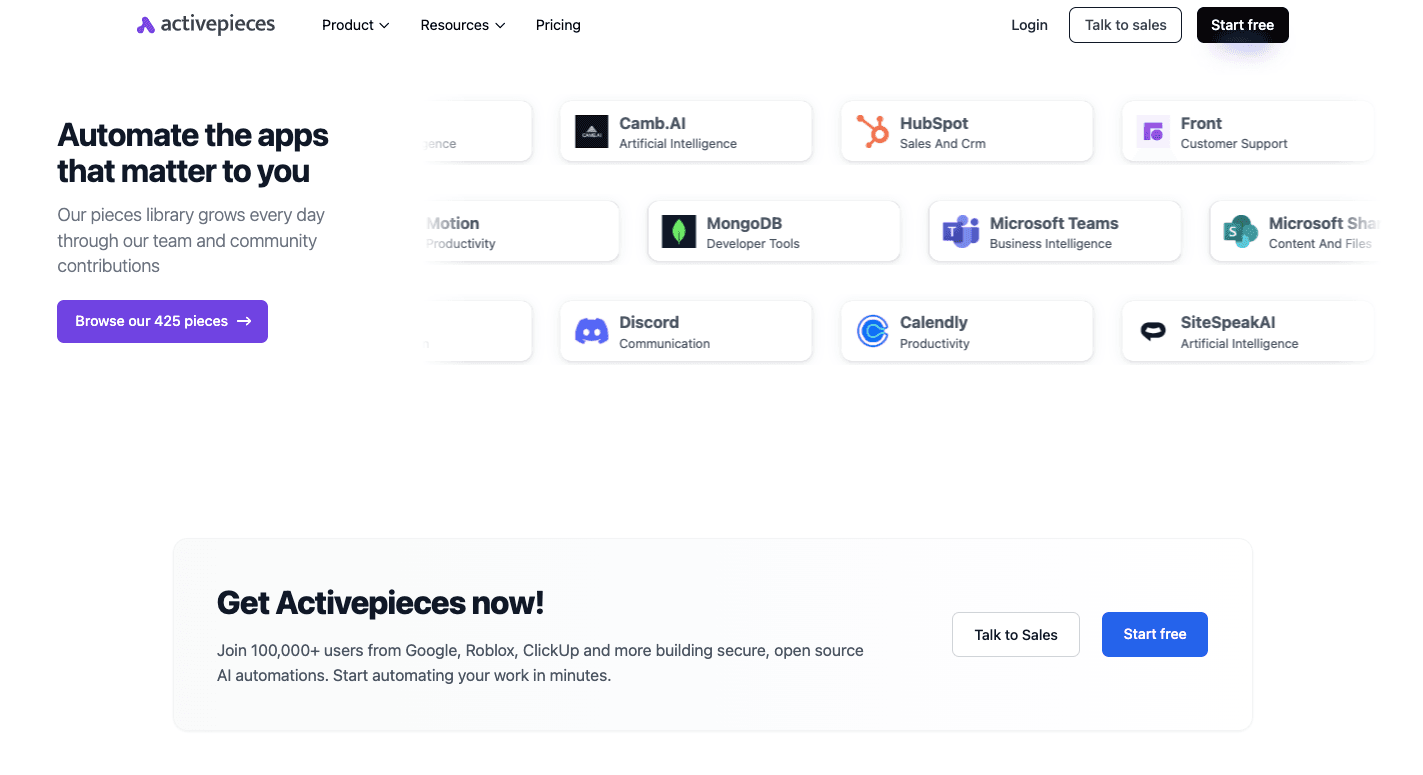
Many people move away from n8n once they realize how much time they lose with its disorganized interface and steep setup requirements. Activepieces, a no-code automation platform, changes that experience with a step-based flow that's easier to follow and faster to debug.
You don't need heavy technical expertise just to get started. Activepieces is accessible and still offers advanced options when you need them.
Since it's a no-code builder, anyone in your team can connect apps, add conditions, and create automations that run smoothly across marketing, sales, or operations. At the same time, developers get access to a TypeScript framework, open source "pieces," and the freedom to extend flows with custom code.
By combining AI-native features, hundreds of integrations, and secure deployment options, Activepieces doesn't just compete with n8n. It surpasses it.
Create your free account today and start building smarter workflows!
FAQs About n8n Alternatives
Which is better than n8n?
Activepieces is better than n8n for most businesses because it offers a no-code builder, self-hosted and cloud hosting options, and a huge app library with more pre-built integrations, while n8n Cloud plans have specific usage limits that vary by subscription tier.
Is n8n or Zapier better?
Zapier is better than n8n for non-technical users who want quick setup and ease of use, while n8n is for technical teams that prefer an open-source automation tool with more flexibility.
What is better, Make or n8n?
Make is better than n8n if you want a visual builder with advanced logic and an intuitive interface, while n8n suits developers who prefer custom workflows and code-level control.
Is n8n a Chinese company?
N8n is not a Chinese company. It was founded in Germany and operates from Berlin.


